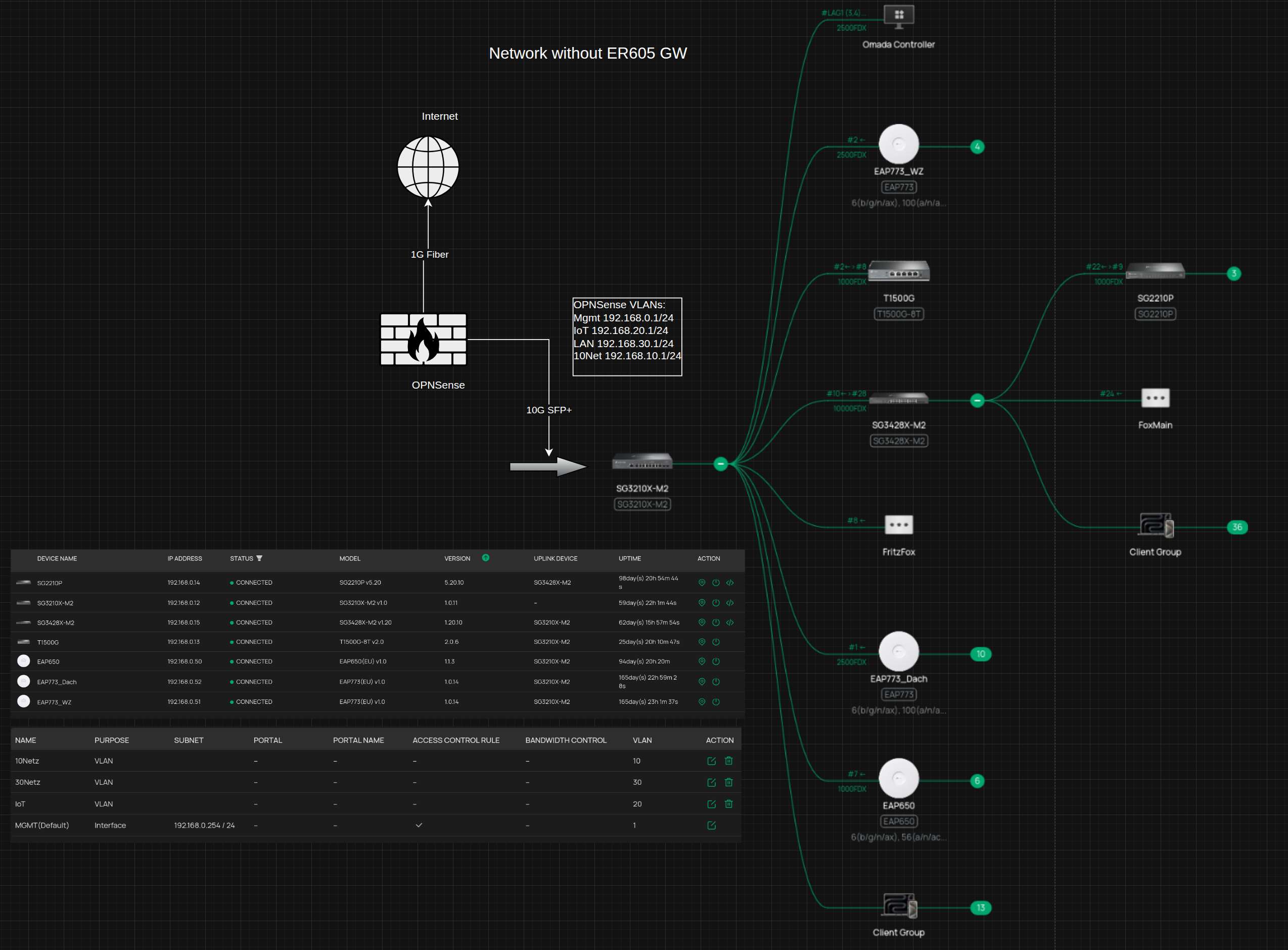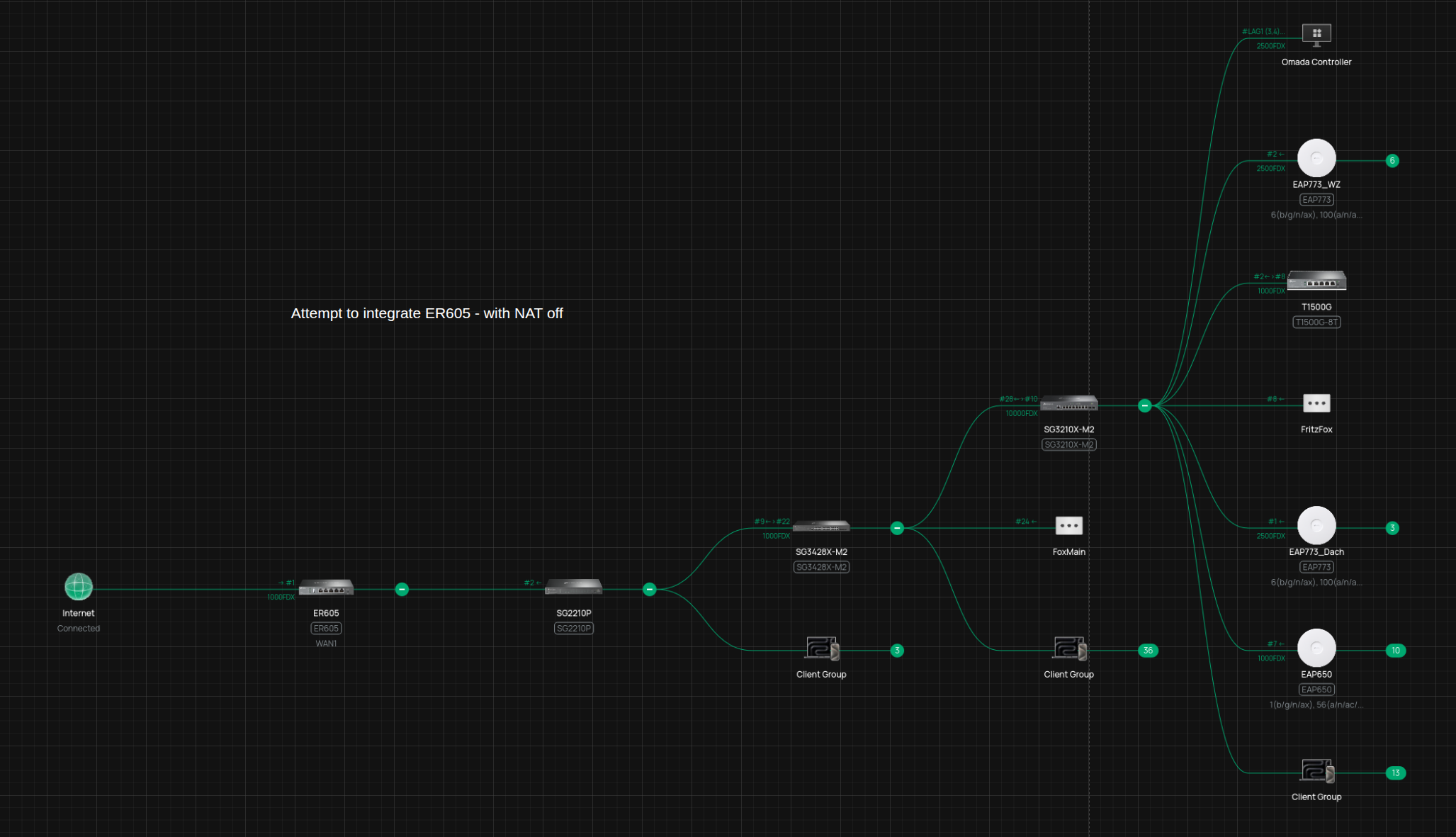Configuration Guide How to Disable NAT on Omada Router
Configuration Guide How to Disable NAT on Omada Router
Background:
This post provides a configuration guide on disabling NAT in standalone mode.
This Article Applies to:
Omada routers with Disable NAT capability.
Configuration Steps:
1. Log in your router.
2. Go to Transmission > NAT > Disable NAT.

Name: specify your rule name.
Interface: choose your WAN.
LAN: LAN port(s) that applies to the rule.
Description: describe your rule.
Status: determines whether the rule is effective.
Note:
1. Configuration steps for Controller mode are similar.
2. Please note that this will involve an adapted firmware, not just a controller update. Firmware development is a complex process, and timelines may change. Therefore, we cannot provide a specific release date at this time. Please stay tuned to future firmware release notes for updates.
3. When introducing a feature like this, we typically apply it uniformly across all models to ensure consistency and a seamless user experience.
However, it's essential to acknowledge that hardware limitations may exist, which might prevent us from adding the feature to certain models. In such cases, we cannot provide individual notifications explaining the reason. Please note that we cannot guarantee the fulfillment of all requests, and we must set clear expectations upfront.
Update Log:
Sep 14th, 2024:
Release of the article.
Recommended Threads:
Configuration Guide How to Configure WireGuard VPN on Omada Controller
Get the Latest Firmware Releases for Omada Routers Here - Subscribe for Updates
Get the Latest Omada SDN Controller Releases Here - Subscribe for Updates
Feedback:
- If this was helpful, welcome to give us Kudos by clicking the upward triangle below.
- If there is anything unclear in this solution post, please feel free to comment below.
Thank you in advance for your valuable feedback!
------------------------------------------------------------------------------------------------
Have other off-topic issues to report?
Welcome to > Start a New Thread < and elaborate on the issue for assistance.
- Copy Link
- Subscribe
- Bookmark
- Report Inappropriate Content
@Clive_A Your initial test does NOT demonstrate what we're trying to accomplish - I have 4 VLANs coming from my OPNSense router - so unclear where to stick the ER605
How do I get the 4 VLANs trunked traffic coming from the OPNSense to the SG3210X-M2 over SFP+ through the ER605 without double NAT ??

This was my attempt to integrate the ER605 - it was recognized on the Omada controller - I disabled NAT - but wasn't sure what LAN & WAN segments to connect it up to ??

- Copy Link
- Report Inappropriate Content
@Clive_A I posted some pictures describing the issue in more detail - any ideas ??
- Copy Link
- Report Inappropriate Content
- Copy Link
- Report Inappropriate Content
@Clive_A You wrote previously "Like I said, you should provide details and a diagram." - I then supply more information and now you just refer me to the "setup guide" again ?!? Which doesn't solve the issue originally raised ?? Not very constructive ?!? It would appear that TP-Link is not very interested in solving the original topic ? ![]()
Could you please explain under what circumstances someone would want to disable NAT based on your guide?? ![]() Use case?
Use case?
- Copy Link
- Report Inappropriate Content
Spanky66 wrote
@Clive_A You wrote previously "Like I said, you should provide details and a diagram." - I then supply more information and now you just refer me to the "setup guide" again ?!? Which doesn't solve the issue originally raised ?? Not very constructive ?!? It would appear that TP-Link is not very interested in solving the original topic ?
Could you please explain under what circumstances someone would want to disable NAT based on your guide??
Use case?
I previously wrote and suggested that you create a separate post to discuss this matter.
You did not create a new post to discuss this. I specifically mentioned this in the previous reply. I wish not to make this post a private support ticket-alike to serve you only. If you intend to get more private support regarding this, I have suggested the proper way.
Secondly, I asked you to read the setup guide, which I created last week, regarding the case you are trying to lay out for me.
Thirdly, this is a community where we encourage you to read, search/research, discuss and share thoughts and guides. We provide support for related topics, but it is not mandatory to answer every question a user asks.
If you are looking for a special agent to answer every question you have back and forth, you can email or chat with the local support team. I have my judgment and choice to choose to reply or not.
I have iterated this several times that "disable NAT" is not what we intended for the Omada router, And we don't have a user context for it. The only user case we know is from your request post, in which everyone in that request post wrote that they need to avoid double-NAT. And this has been addressed by what I wrote last week.
Please take a second to read the guides on the forum. If you are not familiar with the forum system, you can take some time to digest and learn the label and tags we have. Where we hope you can use them to resolve the issue and make a constructive conversation for both you and other users while browsing.
- Copy Link
- Report Inappropriate Content
@Clive_A Understood.
"I wish not to make this post a private support ticket-alike to serve you only." - This is NOT meant for my personal gain - and was meant to improve the Omada offering in general for a growing segment of users. I will seek direct contact with your German colleagues.
Thx anyway.
- Copy Link
- Report Inappropriate Content
Spanky66 wrote
@Clive_A Understood.
"I wish not to make this post a private support ticket-alike to serve you only." - This is NOT meant for my personal gain - and was meant to improve the Omada offering in general for a growing segment of users. I will seek direct contact with your German colleagues.
Thx anyway.
I replied on page 1 on the context and what you should do, which should fix your issue after you disable the NAT. Please take a second and read that part.
And I created a separate setup guide regarding the context and the possible environment. Yet, you seem not to care about the guide we have, where I conclude and summarize details about the product features and break them down for better digestion.
For the general growth of the users, I have created the setup guide, which seems to answer what you are after. I also encouraged you to take a moment to review the community interface and learn how to utilize its features. If you find the interface is not intuitive, you can provide feedback on that so we can improve the UI for the general public welfare.
You seem to wait for me to feed a fix to your mentioned diagram or setup, yet I don't intend to do this on the forum as I explained that this is intended to enlighten people who read this. I gave an example already, which should address what you are looking for, because this example provides a universal guide or explanation to this kind of setup.
What you are trying to do is not possible at all with the Omada router gears. Disabling NAT has nothing to do with the VLAN. This is completely off track from the conversation.
The only fix to your diagram is to remove the second NAT. NAT does the translation but does not process the VLAN.
- Copy Link
- Report Inappropriate Content
@Clive_A I have carefully read every item in this thread - I do not know what you mean about "I created a separate setup guide regarding the context and the possible environment." - are you referring to Post #11 ??
On page one it states: "This post provides a configuration guide on disabling NAT in standalone mode. " - NOT under Omada SDN controlled mode ?!? So not directly addressing the initial ask of disabling NAT and setting a TP-Link Gateway product as a transparent bridge behind a different Internet facing router/FW . . .
As I mentioned previously, this forum as means of interaction regarding the discussed topic appears not to be an efficient means to resolve this matter.
I will escalate with the TPDE colleagues.
- Copy Link
- Report Inappropriate Content
Spanky66 wrote
@Clive_A I have carefully read every item in this thread - I do not know what you mean about "I created a separate setup guide regarding the context and the possible environment." - are you referring to Post #11 ??
On page one it states: "This post provides a configuration guide on disabling NAT in standalone mode. " - NOT under Omada SDN controlled mode ?!? So not directly addressing the initial ask of disabling NAT and setting a TP-Link Gateway product as a transparent bridge behind a different Internet facing router/FW . . .
As I mentioned previously, this forum as means of interaction regarding the discussed topic appears not to be an efficient means to resolve this matter.
I will escalate with the TPDE colleagues.
If you ask what the use case is of disabling the NAT, #11 is the use case.
The description in #12 is not doable. It is about the VLAN instead of the NAT. NAT(L3) is still the barrier that you need to remove, instead of "not translating" (disabling it). It needs to be removed so that layer 2, the VLAN, can work. Disabling the NAT only means the iptables got modified in the sense of layer 3 and 4. This has nothing to do with layer 2, which you hope the VLAN can be forwarded as if it is in the same layer 2(under a switch, in the same local network).
FAQ shows the steps in the Controller and the controller interface offers the same guide and verification like the FAQ from the official website.
Transparent bridge is a whole different story, which has nothing to do with the disabled NAT.
I explained that this product aims to be a router. This is the product orientation. I am not sure why you keep hoping it will be the way you want. You can submit a different request, and we can close this conversation on disabling NAT because it requires a different feature instead of disabling NAT.
- Copy Link
- Report Inappropriate Content
Information
Helpful: 1
Views: 3481
Replies: 19
